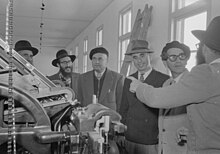Kfar Chabad
Kfar Chabad
כפר חב"ד كفار حباد | |
|---|---|
| Hebrew transcription(s) | |
| • official | Kfar Habad, Kefar Habad |
 Full-scale replica of "770" in Kfar Chabad | |
 Kfar Chabad | |
| Coordinates: 31°59′19″N 34°51′7″E / 31.98861°N 34.85194°ECoordinates: 31°59′19″N 34°51′7″E / 31.98861°N 34.85194°E | |
| Country | Israel |
| District | Central |
| Council | Sdot Dan |
| Affiliation | Chabad |
| Founded | 1949 |
| Population (2019)[1] | 6,598 |
Kfar Chabad (Hebrew: כְּפַר חַבָּ"ד, lit. "Chabad Village") is a Chabad-Lubavitch village in central Israel. Between Beit Dagan and Lod, it falls under the jurisdiction of Sdot Dan Regional Council.[2] In 2019 it had a population of 6,598.[1]
History[]
Kfar Chabad was established in 1949 by Yosef Yitzchak Schneersohn.[3] The site had previously been the depopulated Palestinian village of al-Safiriyya (known to the Byzantines and Crusaders as Sapharea or Saphyria),[4] and as late as 1957 it was referred to in Hebrew as Tzafrir or Shafrir.[citation needed]
The first inhabitants were mostly recent immigrants from the Soviet Union, survivors of World War II and Stalinist oppression. Regarding their aliyah, the Jewish Observer reported: “There were several noteworthy aspect of this Aliyah. Chabad members refused all offers of help from religious and political organizations; they insisted on going on the land. Adapting themselves to modern agricultural methods ... To them it was a point of honor to live as they were taught. This meant subsisting only on what they earned by their own toil".[5]
Kfar Chabad, which is just outside Lod and about 8 km southeast of Tel Aviv, includes agricultural lands as well as numerous educational institutions. It serves as the headquarters of the Chabad-Lubavitch Hasidic movement in Israel. Kfar Chabad is a Lubavitch community.[6]
Replica of "770"[]
The village features a full-scale replica of "770", the world headquarters of Chabad at 770 Eastern Parkway, Crown Heights, Brooklyn, New York, which was built in 1986. The building, which serves as a synagogue, includes the exact same number of bricks as the original structure; the brickwork was produced by Teracotta Ofakim Clay Industries in Ofakim. The Lubavitcher Rebbe covered the US$700,000 building cost.[7]
Railway station[]
Kfar Chabad has a railway station served by trains on the line between Binyamina and Ashkelon. It was built in 1952 and rebuilt in 1999.
Terror attack at the vocational school[]

Vocational school in Kfar Chabad
On 11 April 1956, fedayeens entered the synagogue in a vocational school during evening prayers and started shooting indiscriminately. Five children and one teacher were killed, another ten injured.[8][9]
Education[]
Kfar Chabad provides vocational training in printing, mechanics, carpentry, and agriculture for male students, and education for female students. The programs are combined with religious education.[10] Most students, who come from outside the village, are not Hasidic.[11]
Political leadership[]
Previous mayors include Shlomo Meidanchik and Menachem Lehrer. The current mayor is Nachmen Richman.[12]
Religious leadership[]
The village rabbi was Mordechai Shmuel Ashkenazi from 1983 until his death in 2015. The previous rabbi was Shneur Zalman Gorelik, from the town's founding until his death.[13]
See also[]
| Wikimedia Commons has media related to Kfar Chabad. |
- Kfar Habad Railway Station
- Diamante citron
References[]
- ^ Jump up to: a b "Population in the Localities 2019" (XLS). Israel Central Bureau of Statistics. Retrieved 16 August 2020.
- ^ "Course on Holocaust to begin April 27 in Mtn. Lakes". Archived from the original on October 1, 2014. Retrieved October 1, 2014.
- ^ Chabad.org Calendar
- ^ Khalidi, Walid (1992). All That Remains:The Palestinian Villages Occupied and Depopulated by Israel in 1948. Washington D.C.: Institute for Palestine Studies. p. 253. ISBN 0-88728-224-5.
- ^ Jewish Observer and Middle East Review, 3 July 1959
- ^ "Course in Madison will examine leadership of Talmudic heroes". Retrieved 1 October 2014.
- ^ Rubenstein, Rayle. "The Sincerest Form of Flattery: Replicas around the world". Binah Pesach supplement, 2015, p. 27.
- ^ The Rebbe who saved a village Yediot Acharonot, 5 May 1957
- ^ Bar-On, Mordechai (2012). Moshe Dayan: Israel's Controversial Hero. Yale University Press.
- ^ "Course explores avenues to emerge from times of uncertainty". Retrieved October 1, 2014.
- ^ Despite All Odds: The Story of Lubavitch, Edward Hoffman (New York, 1991, Simon and Schuster), pp. 154–5
- ^ "Six-week course in Madison to study leadership of Talmud heroes". Retrieved 1 October 2014.
- ^ "Class gives portraits of leadership". Archived from the original on 25 October 2014. Retrieved 1 October 2014.
- Sdot Dan Regional Council
- Chabad communities
- Chabad in Israel
- Orthodox Jewish communities
- Populated places established in 1949
- 1949 establishments in Israel
- Religious Israeli communities
- Villages in Israel
- Yosef Yitzchak Schneersohn
- Populated places in Central District (Israel)

